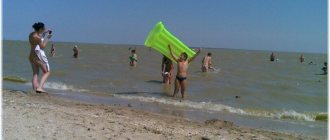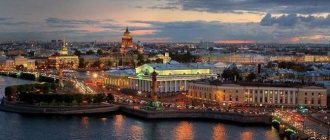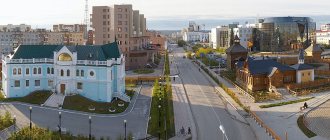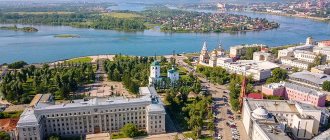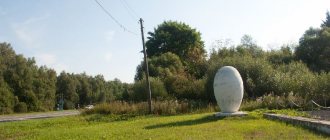Not to be confused with Uzhur-4.
City in Krasnoyarsk Krai, Russia
| Uzhur Uzhur | |
| City [1] | |
| Flag Coat of arms | |
| Location of Uzhur | |
| Uzhur Location of Uzhur Show map of Russia Uzhur Uzhur (Krasnoyarsk region) Show map of Krasnoyarsk Territory | |
| Coordinates: 55°19′03″N 89°49′21″E / 55.31750°N W. 89.82250°E / 55.31750; 89.82250 Coordinates: 55°19′03″N 89°49′21″E / 55.31750°N 89.82250°E / 55.31750; 89.82250 | |
| A country | Russia |
| Federal subject | Krasnoyarsk region [1] |
| Administrative region | Uzhursky district [1] |
| District city | Uzhur [1] |
| Based | 1760 |
| City status from | 1953 |
| Height | 380 m (1250 ft) |
| population size (2010 Census) [2] | |
| • General | 16 093 |
| Administrative status | |
| • Capital from | Uzhur district [1], district town of Uzhur [1] |
| Municipal status | |
| • Municipal district | Uzhur municipal district [3] |
| • Urban village | Urban settlement Uzhur [3] |
| • Capital from | Uzhur municipal district [3], urban settlement Uzhur [3] |
| Timezone | UTC+7 (MSK+4[4]) |
| Postal code [5] | 662250–662255 |
| OKTMO ID | 04656101001 |
| Web site | uzur-admin.ru |
Uzhur
(Russian: Узhur) is a city and administrative center in the Uzhursky District of Krasnoyarsk Krai, Russia, located approximately 300 km (190 mi) from Krasnoyarsk between the Kuznetsk Alatau and Solgon mountain ranges, where the Chernavka River flows into the Uzhurka. Population: 16,093 (2010 census); [2] 17,252 (2002 census); [6] 28,376 (1989 census). [7]
Links[edit]
Church in Uzhur
Notes[edit]
- ^ abcdefgh Law No. 10-4765
- ^ a b Federal State Statistics Service (2011). “All-Russian Population Census 2010. Volume 1" [All-Russian Population Census 2010, vol. 1]. All-Russian Population Census 2010 [All-Russian Population Census 2010]
. Federal State Statistics Service. - ^ abcde Law No. 13-3028
- "On the Calculation of Time". Official Internet portal of legal information
. June 3, 2011. Retrieved January 19, 2022. - Post office. Information and computing center of OASU RPO. ( Post office
).
Search for postal service objects ( postal Search for objects
) (in Russian) - ↑
Federal State Statistics Service of Russia (May 21, 2004).
“The population of Russia, the constituent entities of the Russian Federation as part of federal districts, urban settlements, settlements, settlements of 3 thousand or more people” [Population of Russia, its federal districts, federal districts, districts, urban settlements, rural settlements - administrative centers and rural settlements with a population of more than 3,000 people] (XLS). All-Russian Population Census 2002
. - “All-Union Population Census of 1989. The current population of union and autonomous republics, autonomous regions and districts, territories, negative phenomena, urban settlements and rural district centers” [All-Union Population Census of 1989: current population of union and autonomous republics, Autonomous regions and districts , territories, regions, districts, urban settlements and villages performing the functions of district administrative centers. All-Union Population Census of 1989 [All-Union Population Census of 1989]
.
Institute of Demography of the National Research University: Higher School of Economics [Institute of Demography of the National Research University: Higher School of Economics]. 1989 - via Demoscope Weekly
. - Uzhur city profile
- https://www.janes360.com/images/assets/692/47692/Russia_upgrades_its_missile_arsenal.pdf
Religion
In the 1770s, a wooden Peter and Paul Church was built in the Uzhursky ulus, which was under the jurisdiction of the Tobolsk department. In the first third of the 19th century it was replaced by a stone church. In 1832, the parish was included in the Tomsk diocese, in 1861 - in the Yenisei diocese. In the 1930s, the temple was closed, but in 1946 it was transferred to the Orthodox community and was never closed again. In 2011, a temple was erected at the city cemetery in honor of the New Martyrs and Confessors of Russia. Since March 6, 2012, the parish has belonged to the Sharypovsky deanery of the Krasnoyarsk diocese.
Temples
- New Martyrs and Confessors of Russia, cemetery
- Peter and Paul
Map
| Uzhur: maps |
Uzhur: photo from space (Google Maps) Uzhur: photo from space (Microsoft Virtual Earth)
| Uzhur. Nearest cities. Distances in km. on the map (in brackets along roads) + direction. Using the hyperlink in the distance , you can get the route (information courtesy of the AutoTransInfo website) | |||
| 1 | Solar | 3 (15) | YU |
| 2 | Kopyovo (Republic of Khakassia) | 35 (31) | IN |
| 3 | Sharypovo | 45 (71) | NW |
| 4 | Dubinino | 57 (89) | NW |
| 5 | Novoselovo | 81 (86) | SE |
| 6 | Nazarovo | 85 (97) | NE |
| 7 | Shira (Republic of Khakassia) | 93 (89) | YU |
| 8 | Bogotol | 100 (200) | WITH |
| 9 | Tisul (Kemerovo region) | 106 (156) | NW |
| 10 | Balakhta | 112 () | IN |
| 11 | Achinsk | 113 (133) | NE |
| 12 | Tyazhinsky (Kemerovo region) | 120 (201) | NW |
| 13 | Kozulka | 135 (197) | NE |
| 14 | Bograd (Republic of Khakassia) | 137 (159) | SE |
a brief description of
Located between the Solgon Ridge and the western spurs of the Kuznetsk Alatau, on the Uzhurka and Chernavka rivers, 339 km southwest of Krasnoyarsk. Railway station.
40 km from Uzhur is Lake Uchum, on the southern shore of which there is a mud and balneological resort Uchum, operating since the beginning of the 20th century.
Territory (sq. km): 588
Information about the city of Uzhur on the Russian Wikipedia site
Historical sketch
Founded in 1760 as the Khakassian village (ulus) of Uzhurskoe; name by location on the river Uzhur. Hydronym from Mongolian, Buryat uzhur “river mouth”. Since 1822, the center of the Uzhur volost of the Achinsk district of the Yenisei province.
In 1857, a stone church was built here. In 1890, a telephone exchange appeared.
In 1914, construction of the Achinsk-Minusinsk railway began.
Working village of Uzhur since 1942. City since 1953. The development of the city is associated with the development of nepheline ore deposits in Goryachegorsk and Kiya-Shaltyr.
Economy
Food industry enterprises: meat processing plant, fish factory, butter factory, bakery, food processing plant. Brick and repair factories. Sewing and rolling shops.
Wheat, oats, barley, and potatoes are grown in the Uzhur region. Cattle, pigs, and sheep (fine wool) are raised.
Deposits of basalt, gypsum, limestone, refractory clay.
Culture, science, education
Museum of Local Lore.
In 1922, the writer A.P. served in Uzhur and worked on books. Gaidar (Golikov).
Museums, galleries, exhibition halls
Zlatorunovsky Museum of History and Local Lore 662245, Krasnoyarsk Territory, Uzhursky district, village. Zlatorunovsk
| Population by year (thousands of inhabitants) | |||||||
| 1939 | 14.1 | 1996 | 20.9 | 2007 | 16.1 | 2015 | 15.5 |
| 1959 | 23.5 | 1998 | 20.3 | 2008 | 15.9 | 2016 | 15.6 |
| 1967 | 25 | 2000 | 17.8 | 2010 | 15.5 | 2017 | 15.6 |
| 1970 | 24.5 | 2001 | 17.6 | 2011 | 16.1 | 2018 | 15.6 |
| 1979 | 28.6 | 2003 | 17.3 | 2012 | 15.8 | 2019 | 15.6 |
| 1989 | 28.4 | 2005 | 16.5 | 2013 | 15.5 | 2020 | 15.3 |
| 1992 | 29.1 | 2006 | 16.2 | 2014 | 15.5 | 2021 | 15.2 |
Population[ | ]
| Population | ||||
| 1959[6] | 1970[7] | 1979[8] | 1989[9] | 2002[10] |
| 52 035 | ↘50 173 | ↘50 149 | ↘48 363 | ↘36 169 |
| 2009[11] | 2010[12] | 2011[13] | 2012[14] | 2013[15] |
| ↘33 602 | ↗33 739 | ↘33 575 | ↘33 079 | ↘32 425 |
| 2014[16] | 2015[17] | 2016[18] | 2017[19] | 2018[20] |
| ↘31 981 | ↘31 857 | ↘31 672 | ↘31 545 | ↘31 408 |
| 2019[3] | ||||
| ↘31 124 | ||||
Urbanization
49.26% of the district's population live in urban areas (Uzhur city).
Economy
The economic profile of Uzhur is determined by its position in a large agricultural region and on the railway. Uzhur has a vast territory with highly developed grain production, meat and dairy cattle breeding and sheep breeding. Thanks to this, the city became a major center for processing agricultural raw materials. There are about 50 industrial enterprises of all forms of ownership in Uzhur. The monopoly role belongs to the food industry (up to 90% of the cost of production): a dairy plant, a bakery, and a fish factory that processes imported and local fish (peled, bream, whitefish, and omul are bred in the freshwater lakes of the adjacent territory). There are construction industry enterprises.
Excerpt characterizing Uzhur
“I’m not going anywhere,” Natasha answered when this proposal was made to her, “just please leave me,” she said and ran out of the room, barely holding back tears not so much of grief as of frustration and anger. After she felt abandoned by Princess Marya and alone in her grief, Natasha most of the time, alone in her room, sat with her feet in the corner of the sofa, and, tearing or kneading something with her thin, tense fingers, looked with a persistent, motionless gaze to what the eyes rested on. This solitude exhausted and tormented her; but it was necessary for her. As soon as someone came in to see her, she quickly stood up, changed her position and expression, and took up a book or sewing, obviously impatiently awaiting the departure of the one who had disturbed her. It seemed to her that she would now understand, would penetrate, what her soulful gaze was directed at with a terrible question beyond her power. At the end of December, in a black woolen dress, with a braid carelessly tied in a bun, thin and pale, Natasha sat with her legs in the corner of the sofa, tensely crumpling and unraveling the ends of her belt, and looked at the corner of the door. She looked where he had gone, to the other side of life. And that side of life, which she had never thought about before, which had previously seemed so distant and incredible to her, was now closer and dearer to her, more understandable than this side of life, in which everything was either emptiness and destruction, or suffering and insult. She looked to where she knew he was; but she could not see him otherwise than as he was here. She saw him again the same as he was in Mytishchi, at Trinity, in Yaroslavl. She saw his face, heard his voice and repeated his words and her words spoken to him, and sometimes she came up with new words for herself and for him that could then be said. Here he lies on an armchair in his velvet fur coat, resting his head on his thin, pale hand. His chest is terribly low and his shoulders are raised. The lips are firmly compressed, the eyes shine, and a wrinkle jumps up and disappears on the pale forehead. One of his legs is trembling almost noticeably quickly. Natasha knows that he is struggling with excruciating pain. “What is this pain? Why pain? How does he feel? How it hurts!” - Natasha thinks. He noticed her attention, raised his eyes and, without smiling, began to speak. “One terrible thing,” he said, “is to bind yourself forever to a suffering person. This is eternal torment." And he looked at her with a searching look—Natasha now saw this look. Natasha, as always, answered then before she had time to think about what she was answering; she said: “This cannot go on like this, this will not happen, you will be healthy - completely.” She now saw him first and now experienced everything that she had felt then. She remembered his long, sad, stern look at these words and understood the meaning of the reproach and despair of this long look. “I agreed,” Natasha was now telling herself, “that it would be terrible if he remained always suffering. I said it that way only because it would have been terrible for him, but he understood it differently. He thought it would be terrible for me. He still wanted to live then - he was afraid of death. And I told him so rudely and stupidly. I didn't think that. I thought something completely different. If I had said what I thought, I would have said: even if he were dying, dying all the time before my eyes, I would be happy compared to what I am now. Now... Nothing, no one. Did he know this? No. Didn't know and never will. And now it will never, never be possible to correct this.” And again he spoke to her the same words, but now in her imagination Natasha answered him differently. She stopped him and said: “Terrible for you, but not for me. You know that I have nothing in life without you, and suffering with you is the best happiness for me.” And he took her hand and squeezed it as he had squeezed it on that terrible evening, four days before his death. And in her imagination she told him other tender, loving speeches that she could have said then, which she said now. “I love you... you... I love you, I love you...” she said, convulsively squeezing her hands, gritting her teeth with fierce effort. And sweet grief overwhelmed her, and tears were already welling up in her eyes, but suddenly she asked herself: to whom is she telling this? Where is he and who is he now? And again everything was clouded with dry, hard bewilderment, and again, tensely knitting her eyebrows, she peered at where he was. And so, it seemed to her that she was penetrating the secret... But at that moment, just as something incomprehensible was opening up to her, the loud knock of the door lock handle painfully struck her ears. Quickly and carelessly, with a frightened, uninterested expression on her face, the maid Dunyasha entered the room. “Come to daddy, quickly,” said Dunyasha with a special and animated expression. “It’s a misfortune, about Pyotr Ilyich... a letter,” she said, sobbing. In addition to the general feeling of alienation from all people, Natasha at this time experienced a special feeling of alienation from her family. All her own: father, mother, Sonya, were so close to her, familiar, so everyday that all their words and feelings seemed to her an insult to the world in which she had lived lately, and she was not only indifferent, but looked at them with hostility . She heard Dunyasha’s words about Pyotr Ilyich, about misfortune, but did not understand them.
Interesting Facts
Until 1969 (possibly before 1983) there was a children's railway in Uzhur[17].
- opened: August 1951
- closed: no earlier than 1969
- length: 0.6 km
- 2 stations: “Salyut” and “Pobeda”
- rolling stock: electric locomotive ED-1 and 2 wooden passenger cars
- length: 0.6 km
Throughout history, there were only three electrified children's railways in the USSR: the Children's Railway in Gorky Park in Moscow, the Children's Railway in Uzhur and the Children's Railway in Donetsk. None of them have survived.
The action of the film “The End of the Emperor of the Taiga” begins in Uzhur, when the hero of the film, A.P. Gaidar, utters the phrase: ““I arrived in Uzhur - neither “hello”, nor “bonjour”.
Uzhur
(Krasnoyarsk region)
OKATO code:
04256501
Founded:
1760
Urban settlement since:
1942
City since:
1953 City of district subordination (Uzhursky district of the Krasnoyarsk Territory)
Center:
Uzhursky district
Telephone code (reference phone)
| 39156***** | 21-1-63 |
Deviation from Moscow time, hours:
4
Geographic latitude:
55°19′
Geographic longitude:
89°49′
Altitude above sea level, meters:
380 Sunrise and sunset times in the city of Uzhur
Beauty in Uzhur style: life in a provincial town
Heading to the lakes, many Krasnoyarsk residents have to pass through Uzhur. Nonresident guests usually remember the Uzhur pink elephant - a fountain in the city center, which is difficult for Krasnoyarsk residents to perceive as a fountain. However, it is he who is the unspoken symbol that distinguishes the city from others.
But if you take a closer look, you can see many more interesting things. Here, for example, is Lenin, who leads the country to socialism.
But, probably, the reference point for socialists is the church. Many call this one of the main paradoxes of the city.
Last year Uzhur celebrated its 65th anniversary. There are still many reminders of the Soviet past here.
But the city is developing rapidly - the authorities recently received a new bus after the Universiade. True, so far there is only one - almost like a modern Krasnoyarsk trolleybus. And this is what the rest of the transport in the city looks like.
He walks along new roads past fresh flower beds in the city center.
Past the once renovated retail space. This is what the Trade House looks like, for example. Even before the renovation, it was a Department Store where all Uzhurs shopped. Now half of the departments here are empty - rent is expensive and entrepreneurs are simply giving up space.
And under the cladding of the building there is not the most modern architecture.
And if you walk around the building, even more colorful landscapes will open up. It is a few meters from the main street of the city. There is a small river here that gradually turns into a stream.
But the city can boast of fresh asphalt. There was no longer any left for the exits, but the road itself looks quite neat. There are even traffic lights near schools to highlight crossings.
In general, you can count the number of controlled intersections in the city on one hand. But the traffic here is not so busy, so in the evening the traffic lights are usually turned off.
Secondary roads, especially in the private sector, usually look like this.
The road to one of the best establishments in the city, Papa Miho, looks about the same. The cuisine and service here are not inferior to the restaurants of this chain in Krasnoyarsk, but the parking situation is much worse.
But they are working on sidewalks in the city. Paths and passages near schools now look especially neat and safe.
One of the city's sports clubs also looks modern. True, only one, but with bicycle parking.
A lot is really being done for sports in the city - for example, the Lokomotiv stadium, which is considered the main stadium in the city.
True, up close it looks more modest.
But sports grounds in schools look much worse.
In the educational institutions themselves around the city, plastic windows are installed. The desks are probably also being gradually changed. Or is this a new form of education – TVK News was unable to find out.
And after school, the Uzhur children go to play football.
“You take a picture of this, show the housing and communal services - we have already torn 10 balls here,” the schoolboy shouted when he saw the camera on the playground.
In other yards there are better-kept “boxes”.
And somewhere there are none at all and children just go out to kick a ball in a field near the road.
In other courtyards there are not so much platforms, or even water - people here still go to the water pump with buckets.
Both barns and strange balconies can surprise you with the architecture of courtyards.
There are few five-story houses in the city, most of them are located in the military town and in the SMU microdistrict, but in the latter there are only 5 of them. However, living in apartments, the Uzhurs do not give up their “plots”, growing vegetables right on the site of garage rows, next to them or even along houses.
The situation is absolutely normal for the provinces - for example, a vegetable garden near a modern kindergarten.
In general, you can find many amazing things in the architecture of the city.
Or, on the contrary, the usual ones - for example, the story with fences familiar to Krasnoyarsk.
But if demolished buildings can still be hidden with a fence, then it will not be possible to hide abandoned houses - there are too many of them in the city.
One of the main problems of the city is the swamp, which is growing every year. There is no way to drain it, so people simply leave and abandon their houses, and sometimes entire streets. Gradually the water approaches other buildings and history repeats itself.
But they are trying to green the city. Some parts of it look like this.
Here, next to the old trees, they are trying to grow new ones.
True, the city also has a problem with conifers. For example, it is not very clear how mature trees will live with a tire on the trunk.
A successful example of landscaping is the Uzhursky railway station. Previously, a significant part of the townspeople worked at the depot, but now there are fewer and fewer places left, and many are transferred to branches of other cities.
But the station square still looks very neat.
But residents of the park next to the station are not settling in so quickly.
Another picturesque place is the park in the very center of the city. The already familiar fence and the river, which is gradually becoming smaller.
There is a house right next to the park, next to which, behind a high fence, there are cars. As of 2022, this property belongs to the priest of the local Peter and Paul Church. The temple itself is located literally 200 meters from this place.
Another place that was once a local landmark is the fence along the grain elevator. But it hasn't been updated for many years.
Over the years, vandals have not even raised their hands to spoil this beauty. But time has not been kind to the legendary fence.
In general, this is an ordinary provincial town, where young people often return, and where graduates often leave forever.
Let us remind you that recently the government has become more actively interested in the territories. For example, Yeniseisk should be “born again” for the anniversary, and in the south the edges of the territory will unite around Minusinsk. True, the government does not give an exact time frame for when it will be possible to evaluate the result.

